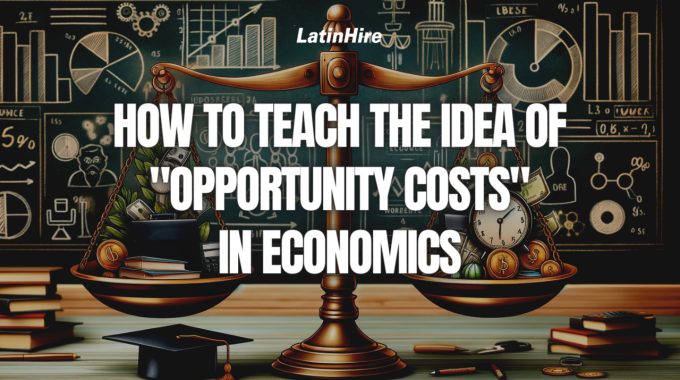In last week’s article, we looked at introducing quantum numbers using a condo analogy as…

How to Teach the Idea of “Opportunity Costs” in Economics
Economics is the science of scarcity, where individuals and societies have to make choices due to limited resources. Brainstorm with your students what resources are limited in our world and they will see that there are a lot!
This brings us to a fundamental concept in economics that plays a big role in decision-making: the idea of opportunity cost. It’s vital for your students to understand opportunity cost first before moving on further topics in economics.
In this article, we’ll explore the essence of opportunity cost, why it matters, and how you as an economics teacher can effectively explain this concept using various examples!
Defining Opportunity Cost

Opportunity cost is the value of the next best alternative given up when a decision is made. In simpler terms, it’s the cost of choosing one option over another. This concept is seen in everyday decision-making, whether on a personal level or in businesses and countries.
Why Opportunity Cost Matters

Resources are limited, yet human wants are unlimited. Opportunity cost is a direct consequence of this scarcity of resources. Explain to your students that every choice we make involves sacrificing one option for another. Ask your students to share a choice they made recently and what other option they had to give up to make that choice.
By understanding opportunity cost and scarcity, individuals must evaluate the relative value of different options. This encourages the allocation of resources to the activities that provide the highest returns or satisfaction. Our economy thrives when resources are used efficiently, so analyzing opportunity costs allows businesses to maximize overall well-being or profits.
Let’s take a look at some examples of opportunity cost in action.
Example 1: The College Dilemma
Consider the classic example of a high school graduate deciding between attending college and entering the workforce directly. If a student chooses to pursue a college degree, her opportunity cost is the potential income she could have earned during those four years of education. Conversely, if she decides to work immediately, her opportunity cost is the potential knowledge and skills she might have gained from a college education.
Example 2: Movie Night vs. Exam Preparation
For students, balancing leisure and academics is a constant struggle. Suppose a student has to choose between movie night with friends and preparing for an upcoming exam. If he chooses the movie night, the opportunity cost is the higher exam score he could have achieved with more study time. If he chooses to study more for the exam, he would forgo a fun night with his friends.
Example 3: Business Investment Decision
In the business world, opportunity cost is crucial when making investment decisions. A company considering two projects must evaluate not only the potential returns of each but also what they are giving up by choosing one investment over the other.
Teaching Opportunity Cost

A simple way to illustrate the idea of opportunity cost is to ask your students to imagine life as a series of interconnected roads. Each decision point represents a fork in the road, and choosing one path means giving up the other possibilities. The road not taken is the opportunity cost.
You can engage your students in decision-making scenarios where they have to weigh different options and understand the consequences of their choices. Use real-world examples and current events to get them to discuss options held by individuals, companies, or governments and analyze the trade-offs involved.
Encourage your students to compare the benefits and drawbacks of different choices. Feel free to use charts, graphs and discussions to highlight the opportunity costs associated with each option.
A tangible and engaging way to teach opportunity costs is to have your students create a game to demonstrate their understanding of the concept. Here are some examples you can try with them.
1. Decision-Making Board Game
Ask students to create a board game where players must navigate through different life scenarios, such as choosing a career path, managing finances, or planning a vacation. Each decision point comes with its opportunity costs, and players must weigh the trade-offs before moving forward.
2. Resource Allocation Card Game
Develop a card game where players receive a set of resources (cards) and must decide how to allocate them among various activities (cards with different benefits). The catch is that each resource spent on one activity cannot be used elsewhere, emphasizing the concept of opportunity cost.
3. Simulated Trading Game
Students can also design a simulated market where they can trade goods or assets. Each participant has limited resources and must decide which items to acquire or trade, taking into account the opportunity costs of choosing one item over another.
Using different examples, games and activities to teach a new concept will help students grasp the ideas a lot easier. We hope this article is helpful for your economics classes in introducing the concept of opportunity cost! By using examples and different teaching strategies, students will have a better grasp of this important idea for both their personal lives and the world around them.



